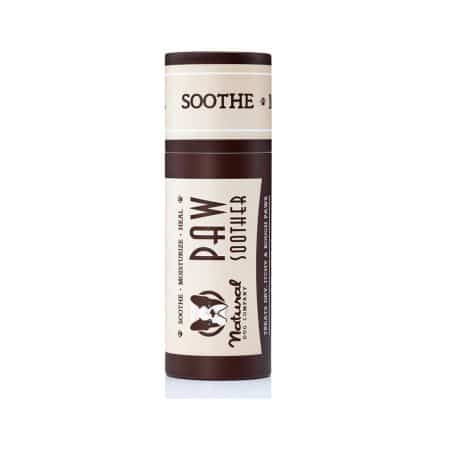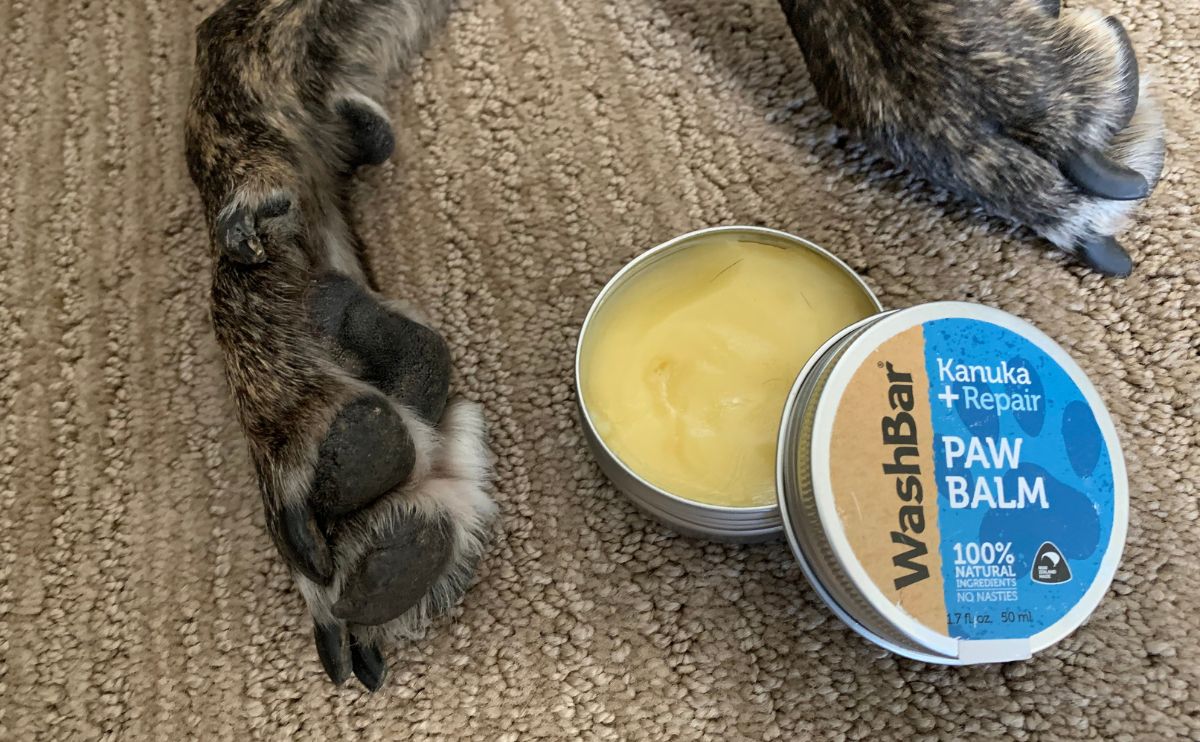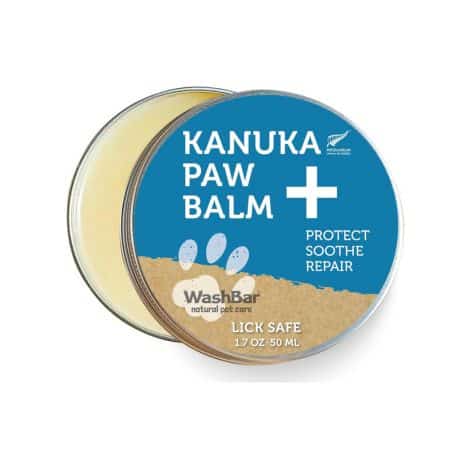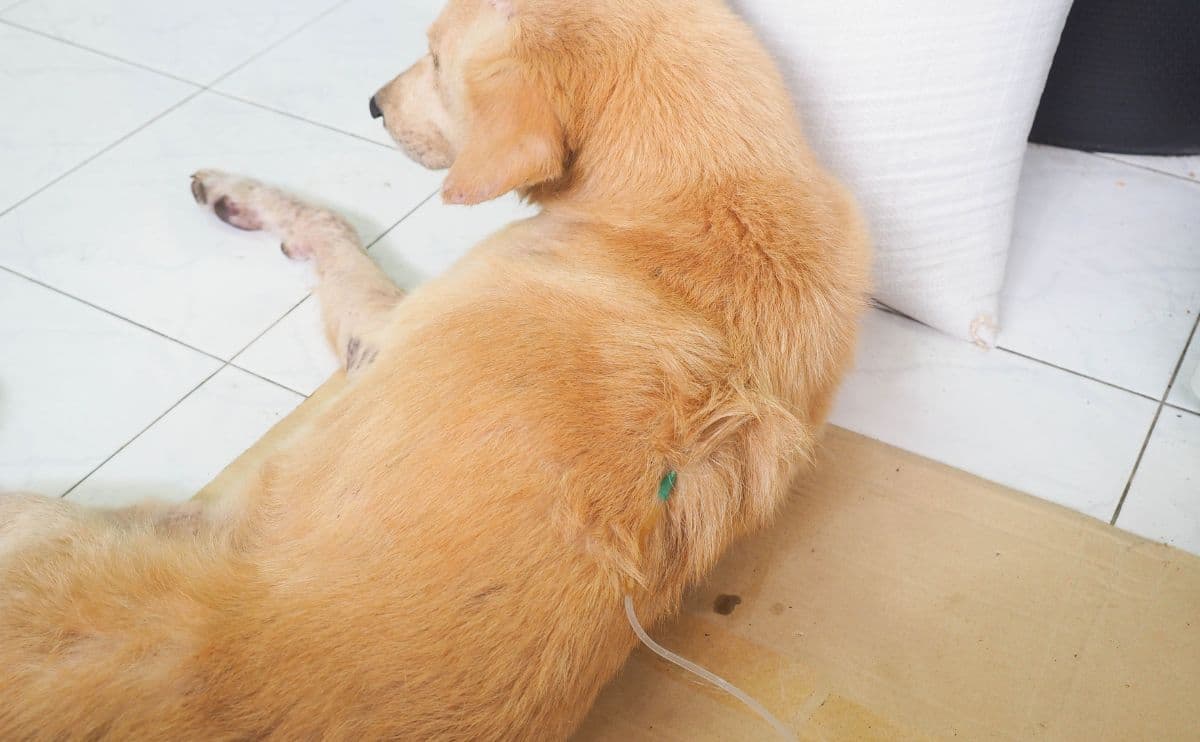This content was reviewed by veterinarian Dr. Elizabeth Racine, DVM.
When you purchase through links on our site, we may earn a commission. Here’s how it works.

My dog, Sally, has had sporadic hyperkeratosis episodes. Hyperkeratosis is also known as hairy dog feet. This is probably self-explanatory, but it’s called this because it looks like your dog is growing abnormal hairs on his skin.
This can be a painful experience, which is why it’s important to take your dog to the vet. There may be an underlying cause as to why your dog has hyperkeratosis.
Sally will go months without any change on her paw pads and then suddenly we’ll notice thickening again, so we begin treatment. I’ll share what I’ve learned throughout Sally’s diagnosis and how we treat it for her.
- What Is Canine Hyperkeratosis?
- What Causes It?
- Is Hyperkeratosis In Dogs Contagious?
- Hyperkeratosis Dog Paw Pad & Nose Treatment
- How Can I Treat My Dog’s Hyperkeratosis At Home?
- Personal Experience: My Dog Was Diagnosed With Hyperkeratosis
- How Can It Be Removed?
- Call Your Vet First
- Should I Get Pet Insurance?
- Healthy Skin And Your Dog's Diet
- Why Trust Canine Journal?
What Is Canine Hyperkeratosis?

Canine hyperkeratosis is when the skin on your dog’s nose or paws thickens and hardens. The hardening is due to excessive growth of the skin cells, which then do not shed. Unfortunately, there is no cure, but there are things you can do to manage your dog’s hyperkeratosis.
This skin condition in dogs occurs when excess keratin is produced. Keratin is a protein that makes the hair, skin, and nails. There are two types of hyperkeratosis: nasal hyperkeratosis in dogs (or dog nose hyperkeratosis) occurs on the nose area, and footpad hyperkeratosis occurs on the paws. Dogs with hyperkeratosis may have dried-out, calloused-looking paws and noses. A secondary infection may develop if the affected skin cracks, causing further pain and discomfort.
Another form of hyperkeratosis can occur on the ear’s outer layer of skin cells. This is often referred to as ear margin seborrhea. It more commonly affects dogs with longer ears, like Cocker Spaniels and Dachshunds.
What Causes It?
Unfortunately, hyperkeratosis is genetic in many cases. Specifically, Labradors, Golden Retrievers, Dogues de Bordeaux, Irish Terriers, and Bedlington Terriers commonly develop this skin condition.
Hyperkeratosis often occurs in the first year of a dog’s life after passing down through genes. Hyperkeratosis also commonly occurs in middle-aged and senior dogs. Skin conditions in dogs, like hyperkeratosis, can also be symptoms of other problems, including the following:
- Canine Distemper – A vaccine is given to puppies for Canine Distemper, which is why this virus is rare.
- Leishmaniasis – A disease caused by a parasite, which is often carried by sandflies. This illness can be controlled with medicine.
- Pemphigus Foliaceus – This is a common autoimmune skin disease that is often diagnosed with a biopsy. It is treatable with immunosuppressive drugs.
- Zinc Responsive Dermatosis – This is a skin disease that can occur if a dog is not absorbing zinc properly. A zinc deficiency causes the paw pads to become swollen, red, and thicker. It can be treated with zinc supplements.
- Age-Related Hyperkeratosis – Some older dogs may develop this condition as they age. The skin may start to thicken as they age, especially in dogs with underlying health issues like liver disease. In older dogs, hyperkeratosis can occur after repeated pressure on the paw pads.
Is Hyperkeratosis In Dogs Contagious?
No, hyperkeratosis is not contagious. It’s sometimes a genetic condition, but it can also be a symptom of an underlying problem listed above.
Hyperkeratosis Dog Paw Pad & Nose Treatment
Looking for hyperkeratosis treatment? There is no cure, but the skin condition can be managed by softening and removing the hardened skin on your dog’s paw pads and nose. Make an appointment with your vet to have this done if necessary. There are a few other medical treatments your vet may try.
- In some cases, hyperkeratosis can occur due to hormonal imbalance. Hormone therapy and supplements may help control excess keratin production.
- If an infection causes hyperkeratosis, antibiotics may need to be prescribed. Vet-prescribed antibiotics may also be required to treat secondary infections that develop.
- Ear margin hyperkeratosis often needs anti-inflammatory medication. Omega-3 fatty acids supplements or dietary additions also support skin health and may be recommended.
How Can I Treat My Dog’s Hyperkeratosis At Home?
A treatment plan from your veterinarian is the best option to treat your pup for hyperkeratosis effectively. You can try a few home remedies that may make your pet more comfortable.
Soaking Feet In Warm Water
A nice soak in warm water and applying petroleum jelly afterward is a safe way to soften and hydrate the affected skin on the feet and paw pads.
A Steam Bath
Steam treatment can also be an excellent way to soften the skin on your pup’s paws and nose. You can make a steam bath by running your shower until the room gets steamy, then letting your dog sit in the bathroom for a few minutes. You do not want them to overheat, so keep this to a few minutes about once or twice a week, and your pup’s skin may start to soften and be more supple.
A Natural Balm
Natural balms for the feet and nose can be effective in keeping the skin soft and helping retain moisture. Shea butter is a desirable choice, especially organic. You can use it alone or in a balm with other ingredients. These balms work like putting moisturizer on your skin or lips. They provide relief as well as a barrier of protection.
Get Your Pup Some Socks
A dog with hyperkeratosis on the feet may have pain when walking. While socks are not necessarily a treatment, they can help protect your pup’s sore feet from the ground. Hot sidewalks, cold, wet ground, rocks, and other things we often step on can be pretty painful to a pup with hyperkeratosis on the paws and can worsen the situation.
Socks provide a protective barrier and can prevent the skin from drying out. They can also be helpful to keep your dog from licking off the shea butter or other balm you use.
Personal Experience: My Dog Was Diagnosed With Hyperkeratosis
My husband noticed a change in our seven-year-old hound mix’s paw pads. All four of her paws had callouses on them, and one day, we noticed she was limping. We took a look and saw that one of the callouses had cracked. Hyperkeratosis was the first thing that came to my mind.
We made a vet appointment immediately and confirmed Sally had hyperkeratosis. Our vet recommended a soothing paw balm to help hydrate Sally’s paw pads and prevent further cracking.

We purchased the Natural Dog Company’s Paw Soother, which improved Sally’s paws quickly. The callouses fell off, and her paw pads became much healthier. Now, we maintain Sally’s paws by applying a paw balm twice daily.

Another one of our favorites is WashBar’s Kanuka + Repair Paw Balm, which was sent to us in exchange for an unbiased review. The consistency of WashBar’s Paw Balm is much smoother and easier to apply than the Natural Dog Company’s. I’d compare it to how Chapstick goes on lips, whereas the Natural Dog Company’s is thicker and needs to melt into the paw more for it to be spread on evenly.

Sally likes to get up immediately after we apply her paw balm, and with the Natural Dog Company’s Paw Soother, there are often marks on our fabric couch from her paws. This doesn’t happen with WashBar’s Paw Balm.
How Can It Be Removed?
As we mentioned above, if your dog has hyperkeratosis, it’s important to keep the skin softened to keep your dog comfortable. If your dog is in pain from the hyperkeratotic paw pads, it may help to have excess skin trimmed off. Make an appointment with your vet, and if you and your vet are comfortable, your vet can teach you how to trim your dog’s paw pads. Here is a video of how the process works.
Call Your Vet First
If your dog has hyperkeratosis, you should take him to the vet. Since hyperkeratosis is a symptom of other illnesses, there is a chance that your dog is sick with something else, as well.
Should I Get Pet Insurance?
Are you worried about your dog’s overall health and the expenses that may come along with it? Pet insurance can help cover any unexpected vet costs. Keep in mind, however, that pet insurance doesn’t cover pre-existing conditions. Find out what pet insurance covers and if it’s worth it in our Pet Insurance 101 guide.
Healthy Skin And Your Dog’s Diet
You can help support your pup’s skin and coat health through a healthy, well-balanced diet. Certain foods, like meats and vegetables, and ingredients like fish oil and flaxseed oil can boost Omega-3 fatty acids. Vitamin A is particularly important to skin and coat health and can be found in egg yolk, carrots, kale, pumpkin, and sweet potatoes, among other foods. You may want to try fresh dog food for your pup or a recipe formulated to boost skin and coat health.
Why Trust Canine Journal?
Kimberly has written about many dog health issues and has first-hand experience with hyperkeratosis. The moment her dog began showing symptoms of hyperkeratosis, Kimberly knew what was going on because of her experience writing about countless dog conditions. She could talk through a treatment plan with her vet and discuss different options to help soften the paw pads and make her dog more comfortable. Kimberly’s knowledge and personal experience with hyperkeratosis make her an authority on the condition.
Tagged With: Reviewed By Dr. Racine, DVM

